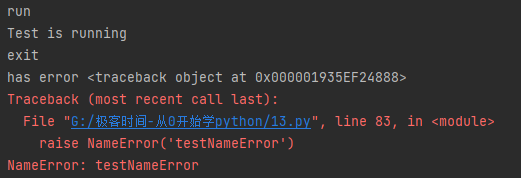1.定义一个类
class Player():
# 类的名称规范上以大写字母开头
def __init__(self,name,hp,occu):
# 名字,血量,职业
self.name=name
# self表示该类实例化后实例本身。
self.hp=hp
self.occu=occu
def print_role(self):
print('%s:%s %s'%(self.name,self.hp,self.occu))
def updateName(self,newname):
self.name=newname
user1=Player('tom',100,'war')
user2=Player('jerry',90,'master')
user1.print_role()
user2.print_role()
user1.updateName('wangsihang')
user1.print_role()
user1.name=('aaa')
user1.print_role()
输出为:

2.继承与多态
class Monster():
# 定义怪物类
def __init__(self,hp=100):
self.hp=hp
def run(self):
print('移动到某一个位置')
def whoami(self):
print('我是怪物父类')
class Animals(Monster):
# 父类放入子类括号中
def __init__(self,hp=10):
self.hp=hp
# 也可以写成 super().__init__(hp)
class Boss(Monster):
# Boss类怪物
def __init__(self,hp=1000):
self.hp=hp
def whoami(self):
# 同名方法在运行过程中可能会有多种状态,这种属性称之为多态。
print('我是Boss')
a1=Monster(200)
print(a1.hp)
print(a1.run())
a2=Animals(1)
print(a2.hp)
print(a2.run())
a3=Boss()
as.whoami()
print('a1的类型 %s' %type(a1))
print('a2的类型 %s' %type(a2))
print('a3的类型 %s' %type(a3))
print(isinstance(a2,Monster))
# 判断a2是否为Monster的子类
输出为:

3.with语句:异常与类的结合
3.1 with语句的意义
在Python中,我们在打开文件的时候,为了代码的健壮性,通常要考虑一些异常情况,比如:
try:
ccfile = open('name.txt')
content = ccfile.readlines()
ccfile.close()
except IOError:
log.write('no data read\n')
如果文件操作出现异常,则写一条错误日志。
考虑一种情况,如果文件打开成功,但readlines()调用失败,异常处理会立即跳转到except处执行,这样文件关闭就没有机会被执行到了。
一种解决办法就是将close()语句放到finally子句中去,finally的特点是不管有无异常,都会被执行到。
try:
try:
ccfile = open('name.txt')
content = ccfile.readlines()
finally IOError:
ccfile.close()
except IOError:
log.write('no data read\n')
或者
fd=open('name.txt')
try:
for line in fd:
print(line)
except Exception:
print('输出错误!')
finally:
fd.close()
但是上面的语句很不优雅。可以使用with语句:
with open('name.txt')as f:
for line in f:
print(line)
下面我们来剖析一下with语句的结构
with context as var:
with_suite
with语句:可以代替try...except...finally语句,使代码更加简洁;
context:通常是表达式,返回一个对象;
var变量:用来保存context返回的对象,可以是单个值或元组;
with_suite:使用变量var对context返回对象进行各种操作的代码段
使用with后不管with中的代码出现什么错误,都会进行对当前对象进行清理工作。 例如file的file.close()方法,无论with中出现任何错误,都会执行file.close()方法。
3.2 异常与类的结合
with只有特定场合下才能使用。这个特定场合只的是那些支持了上下文管理器的对象。
这个管理器就是在对象内实现了两个方法其中为__ enter __( ) 和 __ exit __( )。
参照3.1,open函数也是支持上下文管理器的对象。
__ enter __( ):在使用with语句时调用,上下文管理器在代码开始前调用,返回值与as后面的参数进行绑定。
__ exit __( ):会话管理器在代码块执行完成好后调用,在with语句完成时,对象销毁之前调用。
我们可以自己定义一个带with的方法。即自定义with语句。
class Testwith():
# 自定义with语句的类。
def __enter__(self):
# 上下文管理器
print('run')
def __exit__(self, exc_type, exc_val, exc_tb):
# 上下文管理器
print('exit')
# exc_tb用于判断异常
if exc_tb is None:
print('正常结束')
else:
print('has error %s' %exc_tb)
with Testwith():
print('Test is running')
raise NameError('testNameError')
# 使用raise语句自己触发异常
输出为:























 886
886











 被折叠的 条评论
为什么被折叠?
被折叠的 条评论
为什么被折叠?








